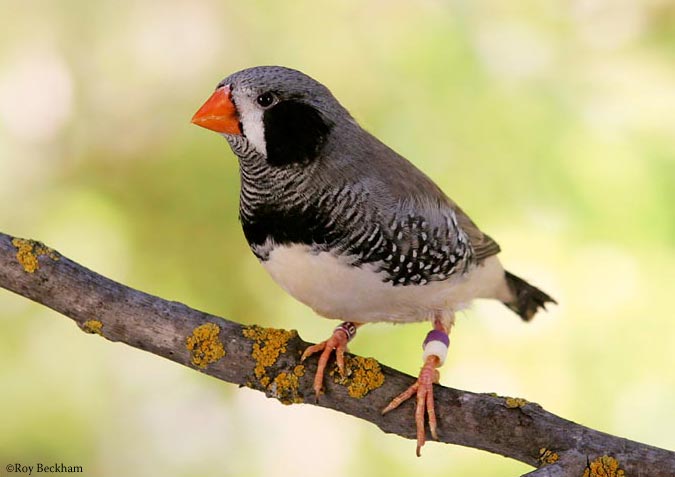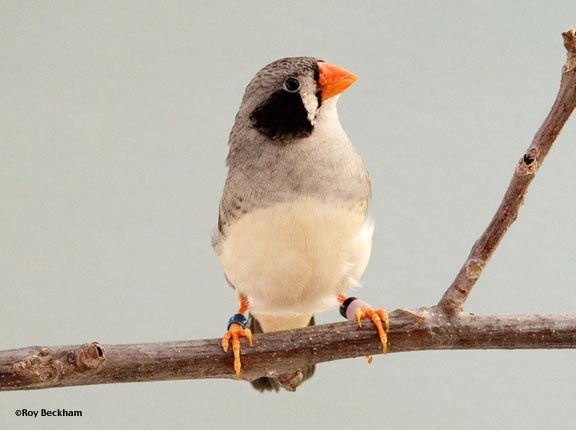




 |
|
|||||||||||||||||||||
 |
|
|
|
|
|
|
|
|
|
|||||||||||||
|
|
|
|
|
|
||||||||||||||||||
|
|
|
|
|
|
|
|
|
|
||||||||||||||
|
|
|
|
|
|
||||||||||||||||||
|
|
|
|
|
|
|
|
|
|
||||||||||||||
|
|
|
|
|
|
||||||||||||||||||
|
|
|
|
|
|
|
 |
|
|||||||||||||||
 |
 |
|
||||||||||||||||||||
|
|
|
|
||||||||||||||||||||
|
|
|
|
|
|
|
|
|
|
|
|
|
|
|
|
|
|
|
|
|
|
|
|
| Black Cheek Zebra Finch | |||
 |
|||
| Black Cheek male | |||
|
Mutation Effects Male: The cheek patches will turn a rich black and the chestnut color of the flanks will turn black as well. Female: This is one of only two mutations where the hen has cheek patches. The female will have black cheek patches similar to the male's. They should not have other male markings, but it is not uncommon for a hen to show smudges in the flanks. Fledgling: The Black Cheek (BC) chicks are immediately identifiable upon gaining their head feathers. The young birds will have full cheek patches with their juvenile plumage. Black Cheek Lightback Fledgling female (click to view) Identifying Splits
Combinations The Black cheek mutation will probably not work with the Florida Fancy or Orange Breasted mutations. Both of these mutations are in conflict with the BC gene. The FF mutation works to reduce all black to white, which would eliminate the cheek and flanks and the OB mutation works to change the black markings to orange, which is in conflict with the way the BC gene works. Another mutation which does not work with the BC is the Penguin mutation. With this mutation, the cheeks and lower abdomen will only allow orange markings and all black markings in these areas are suppressed, so the cheeks will be white. (see a BC Penguin male #1 and #2) It has been reported that for the Black Cheek and Fawn Cheek mutations to be combined, that crossing over of the genes must occur. It was thought that by combining Gray Cheeks (gray series FCs) with Black Cheeks, that a white bird with really dark cheek patches could be produced. Crossing over is a purely random occurrence and cannot be accurately predicted (cross over rate). Black Cheek Lightback (click to view) Black Cheek Penguin-conflicting mutations (click to view) Notes There has been a constant struggle to maintain the quality of the black markings while maintaining size. Some of the difficulties with the Black Cheek mutation include producing full black cheeks on the hens and completely black flanks on the males. A secondary problem of size can occur with BC x BC matings, especially repeated BC x BC mating which are used to improve the quality of the markings. Lately, I have seen a number of BC for sale at the bird marts that were shamefully small and worse yet, the quality of markings on these birds was terrible. These breeders were trying to take advantage of the relatively high price of the Black Cheek Zebra and bred BC x BC without any regard to quality. I have found that my best results were achieved with full BC x BC split matings. Split x split matings can also bring good results with regard to size, but has two disadvantages concerning the quality of markings. While birds of excellent quality can be produced from the mating, it is harder to judge the quality the markings of the birds used in the mating. When selecting full BC birds for the mating, only males with very dark flanks or hens with full cheeks should be used. The other disadvantage to using two splits is that 25% of the young will not carry the BC gene and these may not be accurately identified from the other normal looking birds that are split for BC. Many breeders are combining the Black Cheek mutation with the Fawn mutation to produce birds with dark brown markings rather than black. I have not tried this combination because I feel the two mutations are somewhat in conflict. The fawn mutation is in reality a dilute variety. It has diluted the gray melanins in the feathers so that only the brown tones show through. It also changes some of the gray melanins to brown and perhaps allows more phaeomelanins or orange coloration to show. This produces a pleasing, light brown bird. The BC mutation is trying to darken those markings and to some degree, the whole body. The results I have seen have been poor examples of both mutations. The males had chestnut brown flanks rather than dark, nearly black markings and the overall brown or fawn color of the bird was too dark. |

Black Cheek female
